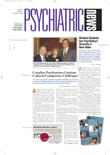Anxiety disorders are among the most prevalent psychiatric conditions in the United States, yet people with anxiety disorders have tended to be under-diagnosed and undertreated (Psychiatric News, August 20).
Now there is some good news: The outpatient treatment of people with such conditions nearly doubled between 1987 and 1999—from 0.43 per 100 Americans to 0.83 per 100 Americans, a highly significant difference.
This finding has emerged from a study headed by Mark Olfson, M.D., a professor of clinical psychiatry at Columbia University and reported in the September Journal of Clinical Psychiatry.
Several factors may have contributed to this increase in treatment. For example, during the 1990s the drug industry intensely promoted the treatment of anxiety. The National Anxiety Disorders Screening Day program, which started in 1994, now operates in more than 1,200 sites in the United States. The Anxiety Disorders Association of America, which reorganized and expanded in 1990, provides consumer education material and a national network to facilitate local mental health referrals.
The study also contains some less upbeat results for the years 1987 to 1999, however—African Americans, Hispanics, and Americans with less than a high-school education had outpatient treatment rates for anxiety far below those of whites and Americans with more education. For example, the national rates per 100 persons treated for anxiety disorders in 1999 were 1.03 for whites, but only 0.37 for Hispanics and 0.24 for blacks.
These are among the other results of the outpatient treatment of anxiety:
•
In 1987 anxiolytics such as benzodiapezines were the most commonly prescribed medications for the treatment of anxiety. By 1999, antidepressants were. This shift can probably be explained by various factors. For example, benzodiazepine use carries the risk of abuse and dependence, especially in patients with comorbid alcohol use disorders. In contrast, clinical trials have come to demonstrate the safety and efficacy of SSRI antidepressants for a range of anxiety disorders. In fact, since the completion of the 1999 survey, several of the newer antidepressants, including venlafaxine–extended release, sertraline, and paroxetine, have received Food and Drug Administration approval for the treatment of additional anxiety disorders.
•
Nonetheless, nearly one-third of anxiety patients treated in 1999 were given benzodiazepines. One reason may be because some psychopharmacologists continue to endorse benzodiazepines as a primary or adjunctive treatment for several anxiety disorders.
•
Patients treated for anxiety in 1999 were about half as likely to receive psychotherapy as they were in 1987. This decline occurred despite accumulating evidence of the efficacy of specific psychotherapies, especially cognitive-behavioral therapy, for anxiety conditions. In contrast, the treatment of anxiety with a combination of psychotherapy and psychotropic medication increased significantly between 1987 and 1999.
•
In 1987, 76 percent of anxious patients were treated by a physician, 18 percent by a psychologist, 5 percent by a social worker, and the remaining by other providers. In 1999, in contrast, 78 percent were treated by a physician, 12 percent by a psychologist, 15 percent by a social worker, and the remaining by other providers.
Data for this study were drawn from the 1987 National Medical Expenditure Survey and the 1999 Medical Expenditure Panel Survey, two nationally representative surveys sponsored by the Agency for Healthcare Research and Quality to provide national estimates of the use, expenditures, and financing of health services. Some 35,000 individuals participated in the 1987 survey, some 24,000 in the 1999 one. Survey staff contacted medical providers to supplement and validate diagnostic and other clinical information given by participants.
The study had certain limitations. For example, whereas data about survey respondents' outpatient visits for the treatment of panic disorder, generalized anxiety disorder, phobias, obsessive-compulsive disorder, acute stress disorder, other anxiety states, and anxiety disorders, unspecified, were available for analysis, no information was accessible about respondents' visits for the treatment of posttraumatic stress disorder or about respondents' visits for the treatment of anxiety due to specific medical illnesses. It was also not possible to determine whether respondents who received treatment for anxiety actually met diagnostic criteria for the selected anxiety disorder codes.
“It was encouraging to see the extent to which advances in treatment, especially advances in the use of antidepressants to treat anxiety disorders, have been disseminated into routine practice,” Olfson said in an interview. Nonetheless, “little is currently done in a systematic manner to detect anxiety disorders in primary care.... Because many socioeconomically disadvantaged groups receive much of their mental health care within primary care settings, efforts should be made to improve the recognition of anxiety disorders in primary care together with referrals as appropriate to psychiatric care.”
The study was funded by Wyeth Research.
The study, “National Trends in the Outpatient Treatment of Anxiety Disorders,” is posted online at<www.psychiatrist.com/privatepdf/2004/v65n09/v65n0903.pdf>.▪
